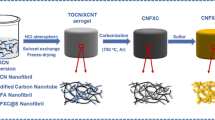Abstract
Nanocrystalline Cellulose (CNC) has smoother surfaces, better optical transparency and higher mechanical strength in comparison with various cellulose fibers. These properties combined with their low cost, light weight, and flexiblility indicate CNC’s great potential as an attractive candidate for preparation of carbon materials, which can be promising electrode for Lithium-ion batteries. However, CNC cannot be directly used in battery fabrication because of its electrically non-conductive property. Wherefore, using pyrolysis to convert CNC into conductive materials is extensively investigated. In our study, high temperature range is used to convert nanocrystalline cellulose into highly conductive carbon material and used in Lithium-ion batteries. The nanocellulose powder after pyrolysis from 800 °C and 1,600 °C is used as active material in Lithium-ion battery electrodes, and the results obtained show a good electrochemical performance with stable cycling capacity. Following, the carbon network obtained through the pyrolysis (800 °C and 1,600 °C) of nanocrystalline cellulose incorporation with tin dioxide (SnO2) was also used as electrode material in Lithium-ion batteries, resulting in stability, outstanding capacity and better performance in comparison with other carbon-based materials.
Similar content being viewed by others
References
H. Zhu, W. Luo, P.N. Ciesielski, Z. Fang, J. Y. Zhu, G. Henriksson, M. E. Himmel and L. Hu, Chem. Rev., 116, 9305 (2016).
Z. Li, J. Liu, K. Jiang and T. Thundat, Nano Energy, 25, 161 (2016).
X. Yang, K. Shi, I. Zhitomirsky and E. D. Cranston, Adv. Mater., 27, 6104 (2015).
L. Wang, C. Schutz, G. Salazar-Alvarez and M. M. Titirici, RSC Adv., 4, 17549 (2014).
X. Du, Z. Zhang, W. Liu and Y. Deng, Nano Energy, 35, 299 (2017).
Z. Wang, R. Pan, R. Sun, K. Edstrom, M. Stromme and L. Nyholm, ACS Appl. Energy Mater., 1, 4341 (2018).
M. L. Foresti, A. Vazquez and B. Boury, Carbohydr. Polym., 157, 447 (2017).
M. C. Hsieh, C. Kim, M. Nogi and K. Suganuma, Nanoscale, 5, 9289 (2013).
J. Lee and J. H. Moon, Korean J. Chem Eng., 34, 3195 (2017).
T. L. Nguyen, T. T. Salunkhe, T. N. Vo, H. W. Choi, Y. Lee, J. Choi, J. Hur and I. T. Kim, J. Power Sources, 414, 470. (2019).
T. N. Vo, H. Kim, J. Hur, W. Choi and I. T. Kim, J. Mater. Chem. A., 6, 22645 (2018).
Y. Chen, J. Ma, Q. Li and T. Wang, Nanoscale, 5(8), 3262 (2013).
S. J. R. Prabakar, Y.-H. Hwang, E.-G. Bae, S. Shim, D. Kim, M. S. Lah, K.-S. Sohn and M. Pyo, Adv. Mater., 25(24), 3307 (2013).
J. Deng, Y. Chen, J. Ma, E. Zhang and T. Wang, J. Nanosci. Nanotechnol., 13(6), 4297 (2013).
Q. Zhao, L. Ma, Q. Zhang, C. Wang and X. Xu, J. Nanomater., 2015, 6 (2015).
X. M. Yin, C. C. Li, M. Zhang, Q. Y. Hao, S. Liu, L.B. Chen and T. H. Wang, J. Phys. Chem. C, 114(17), 8084 (2010).
L. B. Chen, X. M. Yin, L. Mei, C. C. Li, D. N. Lei, M. Zhang, Q. H. Li, Z. Xu, C. M. Xu and T. H. Wang, Nanotechnology, 23(3), 035402 (2011).
L. Fan, X. Li, B. Yan, J. Feng, D. Xiong, D. Li, L. Gu, Y. Wen, S. Lawes and X. Sun, Adv. Energy Mater., 6(10), 1502057 (2016).
J. Liang, C. Yuan, H. Li, K. Fan, Z. Wei, H. Sun and J. Ma, Nano- Micro Lett., 10, 21 (2018).
M. Dirican, Y. Lu, Y. Ge, O. Yildiz and X. Zhang, ACS Appl. Mater. Interfaces, 7(33), 18387 (2015).
B. Huang, X. Li, Y. Pei, S. Li, X. Cao, R. C. Massé and G. Cao, Small, 12(14), 1945 (2016).
S. Kuga, D. Y. Kim, Y. Nishiyama and R. M. Brown, Mol. Cryst. Lip. Cryst., 387, 13 (2002).
Z. Lin, X. Xiong, J. Zheng, G. Wang and C. Yang, Mater. Lett., 202, 123 (2017).
Y. Luo, X. Zhou, Y. Zhong, M. Yang, J. Wei and Z. Zhou, Electrochim. Acta, 154, 136 (2015).
C. Zhu, X. Xia, J. Liu, Z. Fan, D. Chao, H. Zhang and H. J. Fan, Nano Energy, 4, 105 (2014).
B. Jiang, Y. He, B. Li, S. Zhao, S. Wang, Y. B. He and Z. Lin, Angew. Chem. Int. Ed., 56(7), 1869 (2017).
M. Zhang, Z. Sun, T. Zhang, D. Sui, Y. Ma and Y. Chen, Carbon, 102, 32 (2016).
R. Li, B. Wang, S. Ji and P. Jin, RSC Adv., 6(59), 54179 (2016).
R. Hu, Y. Ouyang, T. Liang, H. Wang, J. Liu, J. Chen, C. Yang, L. Yang and M. Zhu, Adv. Mater., 29(13), 1605006 (2017).
S. I. Oh, J. C. Kim and D. W. Kim, Cellulose, 26, 2557 (2019).
Z. Chen, Z. Xu, W. Li, C. Chen, J. Yang, J. Liu, F. Gong, J. Liao and M. Wu, ACS Appl. Energy Mater., 2, 5171 (2019).
M. Wang, S. Li, Y. Zhang and J. Huang, Chem. Eur. J., 21, 16195 (2015).
Acknowledgements
This research was financially supported by Korea Electric Power Corporation (Grant number: R18XA02) and by the Korea Institute of Energy Technology Evaluation and Planning (KETEP) and the Ministry of Trade, Industry & Energy (MOTIE) of the Republic of Korea (No. 20194030202290). We very much appreciate all measurement instruments, supported by Smart Materials Research Center for IoT in Gachon University.
Author information
Authors and Affiliations
Corresponding author
Rights and permissions
About this article
Cite this article
Tran, Q.N., Kim, I.T., Hur, J. et al. Composite of nanocrystalline cellulose with tin dioxide as Lightweight Substrates for high-performance Lithium-ion battery. Korean J. Chem. Eng. 37, 898–904 (2020). https://doi.org/10.1007/s11814-020-0506-5
Received:
Accepted:
Published:
Issue Date:
DOI: https://doi.org/10.1007/s11814-020-0506-5




